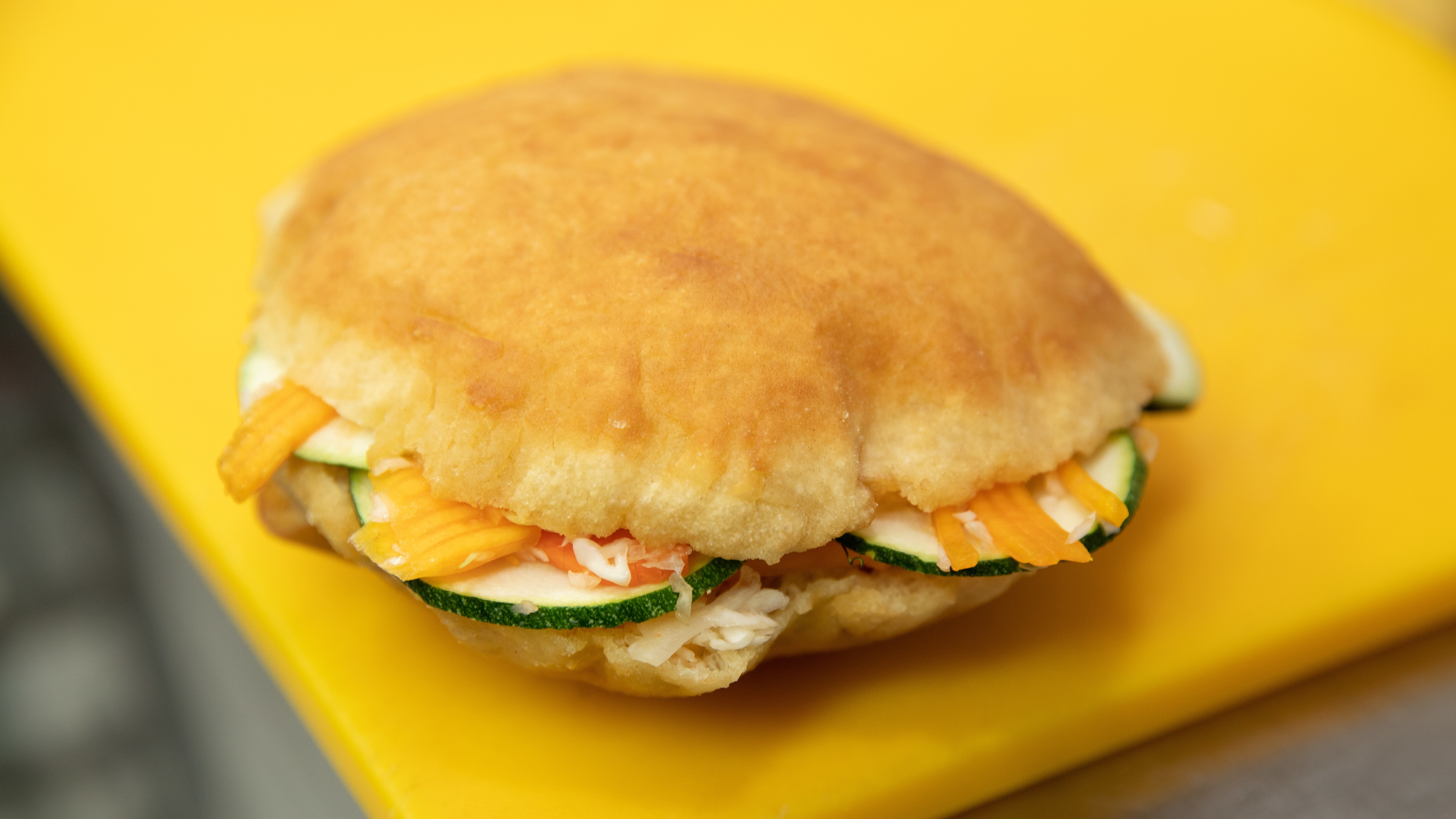The Crispy, Golden Joys Of Guadeloupe's Bokit
Most people remember the milestones in their lives as a series of firsts: first kiss, first time behind the wheel, first sip of alcohol. For as long as I live, I will always remember my first bokit. I had landed on the dreamy archipelago of Guadeloupe earlier that week and spent most of my time sampling the island's French fusion cuisine, dishes like feroces d' avocat (spicy avocado salad with cassava and codfish) and souskai (green fruits with lime and hot pepper). By the third day, I thought I had crossed most of Guadeloupe's signature foods off my list. Fortunately, I was wrong.
Audrey, a Guadeloupean who now lives in New York, took me to a ramshackle storefront and explained that I could not leave Gwada without trying a bokit. A list of a dozen ingredients lined the walls, from lamb to curried lobster, but I chose the familiar saltfish filling. I watched as the shop owner fried two long pieces of flat dough and then stuffed saltfish, lettuce, and sauces between them. He handed it to me wrapped in foil. I unwrapped it, took a little bite, and felt my eyes pop out of my face. Audrey smirked.
Nicknamed the Creole burger, the bokit is an iconic Guadeloupean street food seemingly adored by all. Its use of fried dough—which is filling enough on its own—means that the bokit is much heartier than most sandwiches, an entire entree of meats, cheeses, and vegetables crammed between sturdy fry bread. The oily flavor of the fried dough blends with all the fillings (and there can be up to half a dozen) for a satisfying mix of fat and freshness. There are dozens of sauces that you can add to a bokit: pepper sauce, creole sauce (scotch bonnet peppers, onion garlic, lime, parsley), curry sauce, ketchup, many of which are housemade depending on where you go.
Designated as a French overseas region, the Eastern Caribbean archipelago of Guadeloupe is noted for cuisine that blends African, Indian, and indigenous flavors with French cooking techniques. The region's two largest islands, Basse-Terre and Grande-Terre, form a butterfly shape in the southern Caribbean Sea, and the land exudes a sun-drenched, Creole flair. Walking around Pointe-à-Pitre on Grande-Terre, I glimpsed locals carrying fresh sugarcane juice sold in plastic bottles on corners, codfish fritters called accras piled into bags for snacking, and baguettes tucked under their arms. The various food traditions appeared everywhere all at once. (In fact, it's no coincidence that Guadeloupe's most famous band, the legendary zouk ensemble Kassav', is named for a local cassava pancake typically stuffed with coconut.)
The island may be known for its golden beaches and stylish joie de vivre, but food is a huge part of that, playing a significant role in the Guadeloupean lifestyle. The island's signature cultural event each year is La Fête des Cuisinières, or the Festival of Female Chefs. Celebrated every August for over a century, the chefs dress in traditional madras dresses and headscarves and walk in procession to Pointe-à-Pitre's Basilica of St. Peter and St. Paul to have baskets of food, flowers, and cooking utensils blessed by the priest. The celebration is topped off with folk music and, of course, a feast: spectators sample the chefs' special Creole dishes like grilled fish with court-bouillon or porc-colombo, the curry-spiced national dish of Guadeloupe. After all, it's not a celebration without an excess of food.
I didn't realize just what kind of celebration I was in for when I walked over to the bokit stand to place my first order. Although it's presented as street food, the bokit is really a portable feast, and on every corner of the island, bokit stalls or food trucks can be found serving the local delicacy. Bokits, in fact, seemed as ubiquitous as the seagrape trees that dot Guadeloupe's beaches. Holding the hefty sandwich in my hands, the most recognizable part was the fried bread. Called Johnny cakes in most of the Caribbean, this fried dough's roots can be traced to the indigenous practice of cooking corn cakes on hot stones. Stuffing the bread with enough fixings to sustain several people is thought to have started shortly after slavery was abolished in Guadeloupe in 1848. Poor workers wanted a cheap and filling alternative to the sandwich, so they used elongated fried bread and filled it with meat, cheese, sauces, and anything else that could fit (which was a lot more than a typical sandwich could). Today you can find almost anything stuffed into a bokit: chicken, bacon, conch, or mutton. Whatever the ingredients, it's guaranteed to be delicious and, in my case at least, last several days. You can grab bokits anywhere in Guadeloupe, including the popular Bokit Delux in Pointe-à-Pitre. For the most creative takes, look no further than the food trucks serving their own unique bokits in the beach town of Sainte- Anne.
